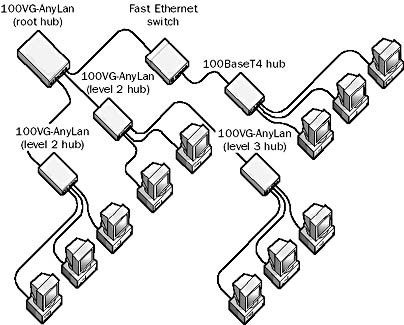In the annals of networking technology, certain innovations blaze a trail only to be overshadowed as the industry evolves. 100VG-AnyLan represents one such chapter, offering a glimpse into an era where competing standards vied to define the future of high-speed networking. Born from the collaborative efforts of Hewlett-Packard and the IEEE’s Project 802, 100VG-AnyLan, informally known as 100BaseVG, aimed to revolutionize Ethernet communications with a 100-Mbps protocol.
This article journeys through the rise and fall of 100VG-AnyLan, examining its technological underpinnings, the competition with Fast Ethernet, and its lasting legacy in network technology’s vast tapestry.
In this article:
- The Genesis of 100VG-AnyLan
- Technical Innovations and Features
- Comparative Analysis: 100VG-AnyLan vs. Fast Ethernet
- The Decline of 100VG-AnyLan
- Legacy and Lessons Learned
- References

1. The Genesis of 100VG-AnyLan
Origins and Development
100VG-AnyLan emerged in the early 1990s as a collaborative effort primarily led by Hewlett-Packard. This initiative aimed to address the burgeoning need for higher network speeds that could support the increasing data demands of businesses and emerging internet technologies. Positioned as an alternative to the traditional Ethernet standards, 100VG-AnyLan sought to offer a robust solution capable of delivering 100 Mbps performance, a significant leap from the prevailing 10 Mbps Ethernet speeds. The development of 100VG-AnyLan, which was informally named 100BaseVG, was a response to the limitations observed in existing networks, focusing on improving data handling, efficiency, and overall network reliability.
IEEE 802.12 Specifications
Under the auspices of the IEEE’s Project 802, the 802.12 committee was formed to standardize the 100VG-AnyLan technology. The IEEE 802.12 specifications outlined the operational principles of 100VG-AnyLan, defining its unique approach to data transmission. Unlike traditional Ethernet that utilized Carrier Sense Multiple Access with Collision Detection (CSMA/CD), 100VG-AnyLan introduced a deterministic data transfer method, leveraging a demand priority protocol. This protocol enabled more efficient management of data packets, significantly reducing the chances of collision and ensuring a smoother flow of information across the network.
2. Technical Innovations and Features
How 100VG-AnyLan Worked
100VG-AnyLan revolutionized network data transmission through its innovative use of the demand priority protocol. This system prioritized traffic based on the urgency of the data, allowing high-priority packets to bypass lower-priority ones, effectively reducing transmission delays. The technology employed a four-ring topology to manage data paths, enabling simultaneous transmissions and enhancing the network’s overall capacity. Each packet was tagged with a priority level, and network switches dynamically allocated bandwidth, ensuring that critical data was transmitted with minimal latency.

Installing a 100VG-AnyLan (technical details)
100VG-AnyLan networks are wired together in a star topology using unshielded twisted-pair (UTP) cabling, shielded twisted-pair (STP) cabling, or fiber-optic cabling with supporting 100-Mbps hubs or Ethernet switches. If UTP cabling is used, it can be category 3 cabling, category 4 cabling, or category 5 cabling – with category 5 (CAT5) cabling or enhanced category 5 cabling preferred. 100BaseVG uses all four pairs of wires in UTP cabling. When using UTP category 3 cabling, category 4 cabling, or STP cabling, the maximum length of a segment is 100 meters. With UTP category 5 cabling, the maximum length of a segment is 200 meters. When using multimode fiber-optic cabling, the maximum length is 2000 meters.
Key Technological Differentiators
Several technological differentiators set 100VG-AnyLan apart from its contemporaries:
- Demand Priority Protocol: Unlike the stochastic CSMA/CD protocol, 100VG-AnyLan’s demand priority system provided a structured mechanism for traffic management, significantly reducing packet collision and network congestion.
- Support for Multiple Media Types: 100BaseVG was designed to operate over both copper and fiber optic cabling, offering flexibility in deployment and ensuring that networks could leverage existing infrastructure while benefiting from increased speeds.
- Enhanced Error Handling: The protocol incorporated robust error detection and correction mechanisms, improving data integrity and reliability.
- Scalability: With its efficient bandwidth management and support for mixed media, 100VG-AnyLan was highly scalable, suited for both small and large network installations.
These innovations underscored 100VG-AnyLan’s potential to redefine network performance standards. However, despite its technical merits, the adoption of 100BaseVG faced challenges in a market rapidly coalescing around the competing Fast Ethernet standard.
3. Comparative Analysis: 100VG-AnyLan vs. Fast Ethernet
Performance Benchmarks
When comparing 100VG-AnyLan to Fast Ethernet, both technologies promised to deliver 100 Mbps speeds, a significant improvement over the then-standard 10 Mbps Ethernet. 100BaseVG’s demand priority protocol offered a theoretical advantage in environments with mixed traffic loads, potentially reducing latency for high-priority traffic. However, in practice, the performance gains of 100VG-AnyLan were not uniformly evident across all network configurations, partly due to its more complex hardware requirements and the efficient evolution of Fast Ethernet technology, which quickly adopted switching techniques to minimize collision domains and enhance throughput.
Market Adoption Challenges
100VG-AnyLan faced significant market adoption challenges, primarily due to its late entry into a market already leaning towards Fast Ethernet. Fast Ethernet’s compatibility with existing 10 Mbps Ethernet infrastructure, coupled with lower cost and simpler implementation, gave it a decisive edge. Additionally, the rapid standardization of Fast Ethernet by the IEEE and its broad industry support contributed to its dominance, leaving 100BaseVG with a limited vendor and user base.
4. The Decline of 100VG-AnyLan
Factors Leading to Its Obsolescence
The decline of 100VG-AnyLan can be attributed to several key factors:
- Competition from Fast Ethernet: Fast Ethernet’s rapid evolution and the industry’s coalescence around this standard made it difficult for 100VG-AnyLan to gain a foothold.
- Complexity and Cost: The implementation of 100BaseVG required more sophisticated and thus more expensive network hardware compared to Fast Ethernet solutions.
- Lack of Backward Compatibility: Unlike Fast Ethernet, which offered seamless integration with existing Ethernet networks, 100VG-AnyLan required a more significant overhaul of network infrastructure.
Transition to Dominant Ethernet Standards
As Fast Ethernet became the de facto choice for high-speed networking, 100VG-AnyLan’s presence dwindled. The networking industry’s shift towards Gigabit Ethernet and beyond further marginalized 100VG-AnyLan, cementing Fast Ethernet and its successors as the primary standards for wired networking.
5. Legacy and Lessons Learned
Contributions to Networking Technology
Despite its decline, 100VG-AnyLan contributed valuable insights into network design, particularly efficient bandwidth management and prioritization. Its demand priority protocol showcased an early attempt to address network congestion and quality of service, concepts that remain central to modern network management.
Impact on Future Network Design
The principles underlying 100VG-AnyLan’s design have influenced subsequent developments in networking, including the emphasis on traffic prioritization and advanced error correction techniques. The lessons learned from the 100BaseVG experience have underscored the importance of industry standardization, backward compatibility, and the need for scalable, cost-effective solutions in driving technology adoption.
6. References
- Books:
- “Data and Computer Communications” by William Stallings – Offers a comprehensive overview of networking concepts, including detailed discussions on Ethernet standards.
- “Networking Essentials” by Jeffrey S. Beasley and Piyasat Nilkaew – Provides insights into foundational networking technologies and protocols, with historical context on Ethernet developments.
- RFCs:
- RFC 1236 – “TCP/IP X.25 and X.121 Address Mapping” – While focusing on address mapping, this RFC provides background on the networking context in which 100VG-AnyLan was developed.
- IEEE 802.12 – While not an RFC, the IEEE 802.12 standards documents are critical primary sources detailing the technical specifications of 100VG-AnyLan.
- Other Resources: